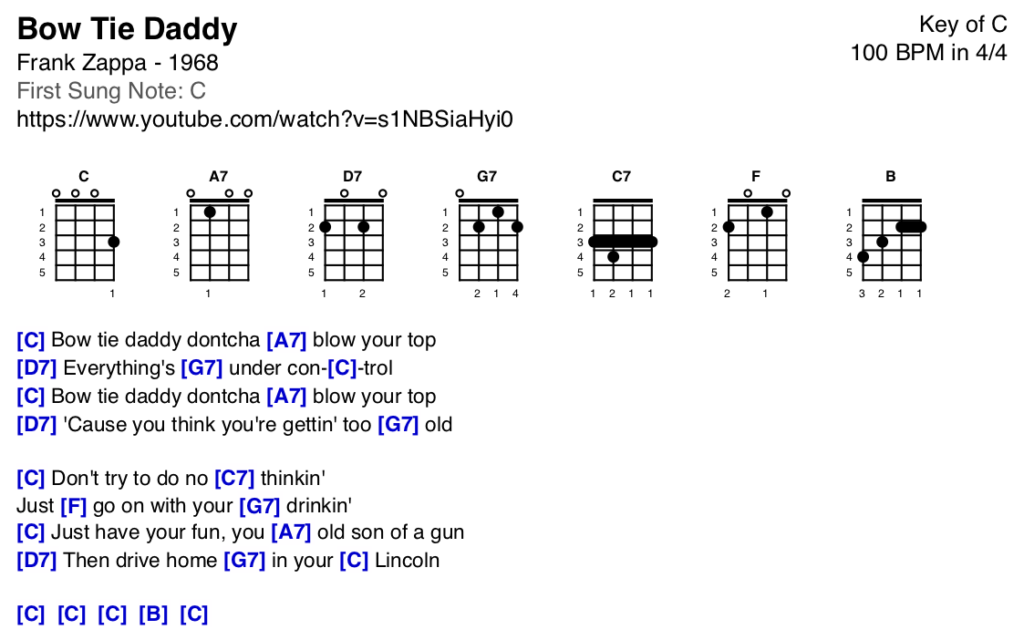We use an iPad program called OnSong to project our songs each week at TUG. The songs we project are formatted using a simple text file format called ChordPro. By using the ChordPro format files in OnSong we can do things like change the key on the fly, display chord diagrams in different places, set the size and color of the fonts and chords, etc.
The format of a ChordPro file is really pretty simple. The chords are placed in square brackets ([]) where they should appear in the lyrics.
[C] Cecilia, you're [F] breaking my [C] heart,
you're [F] shaking my [C] confidence [G7] daily
Oh, [F] Cecili-[C]-a, I'm [F] down on my [C] knees;
I'm [F] begging you [C] please to come [G7] home.
Note that the chords can be placed in the middle of words. For TUG when a chord appears within a word we add dashes before and after the chord (ex-[G7]-ample). Also, for TUG we try to keep a space between any word and a chord – this just makes the final chord chart a little easier to read.
The file format is a simple text file that you can edit with TextEdit or Notepad. It is better not to use a word processor such as Word – they add hidden characters which can make the song format strangely.
So, a simple text file of the lyrics with chords in square brackets is all you need to format a song for us to display. Everything else is completely optional. Here’s a few other formatting options you can use.
If you’d like to add musical directives – like “Play softly here” – you can use a comment tag. Put it on it’s own line and enclose it with curly brackets ({}).
{comment:Play Softly Here}
or
{c:Play Softly Here}
Since choruses tend to repeat, you can just enter the chorus once, then merely refer to it later in the song. You can define the chorus using {start_of_chorus} and {start_of_chorus} (or, if you like, {soc} and {eoc}.)
{start_of_chorus}
A very merry [G]Christmas - And a happy New [A]Year
Let's hope it's a [Em]good one - [G]Without any [D]fear [E]
{end_of_chorus}
or
{soc}
A very merry [G]Christmas - And a happy New [A]Year
Let's hope it's a [Em]good one - [G]Without any [D]fear [E]
{eoc}
For TUG a chorus marked this way will be indented and bolded. When the chorus comes up later in the song you can use a comment line to indicate it:
{comment:Chorus}
or
{c:Chorus}
We always add a title and composer line in our TUG songs. Enter the title at the top of your file like this:
{title:Let it Be}
or
{t:Let it Be}
The author line should be right below the title – we use the subtitle tag for this:
{subtitle:John Lennon/Paul McCartney}
or
{st:John Lennon/Paul McCartney}
For our TUG files – the first two lines look like this:
{title:Let it Be}
{subtitle:John Lennon/Paul McCartney}
That’s really all there is to it. Here’s a short song file in our TUG format. You can see the additional optional fields at the top of the file.
{t:Bow Tie Daddy}
{st: Frank Zappa - 1968}
{key:C }
{duration:120}
{time:4/4}
{tempo:100}
{book: Q119}
{keywords:ROCK}
{c: First Sung Note: C }
https://www.youtube.com/watch?v=s1NBSiaHyi0
[C] Bow tie daddy dontcha [A7] blow your top
[D7] Everything's [G7] under con-[C]-trol
[C] Bow tie daddy dontcha [A7] blow your top
[D7] 'Cause you think you're gettin' too [G7] old
[C] Don't try to do no [C7] thinkin'
Just [F] go on with your [G7] drinkin'
[C] Just have your fun, you [A7] old son of a gun
[D7] Then drive home [G7] in your [C] Lincoln
[C] [C] [C] [B] [C]
And here’s what it looks like formatted in OnSong.

Check out the links in the ChordPro Format Sources section to the right for places to find songs in ChordPro format and tools for creating and viewing ChordPro files.
